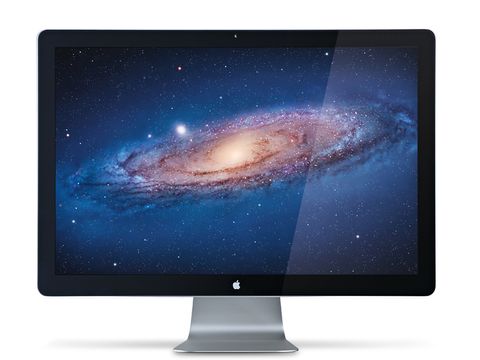TechRadar Verdict
Pros
- +
A good display
- +
Single cable convenience
- +
Boon for MacBook owners
- +
Daisy-chaining Thunderbolt
Cons
- -
Limited compatibility
- -
Expensive
Why you can trust TechRadar
Glance at Apple's new Thunderbolt Display and you might mistake it for an iMac. Look a bit closer, and you might still be fooled – the display is the same as the panel used in the current 27-inchers.
Even if you were to take it apart, the sheer volume of chips, ports, fans and assorted gubbins inside it might not convince you that this is just a monitor. But it's more than just a monitor!
Let's start with its performance as a straight display, though. It's entirely as we've come to expect from Apple: a glossy panel (no option for matte) with a high resolution and gloriously wide viewing angles. As usual, colours are good – if perhaps no more than good in the eyes of demanding creative professionals – and the general feel is rewarding.
27-inches can dominate many desks, but it's undeniably lovely to have so much space in which to stretch out. So far, so utterly predictable for an Apple monitor: an entirely competent display.
While it can be bettered in price by Dell's UltraSharp U2711 which uses the same panel (and is available online for as little as almost half) and bettered in image quality from high-end displays from NEC and Eizo, it's still an object of lust for many folks who own other Apple kit.
The clue to the Thunderbolt Display's uniqueness, however, is in its name; it connects not with VGA, DVI, HDMI or even Mini DisplayPort, but using the new Thunderbolt connector. While this means that you have to have a Thunderbolt-equipped Mac in order to use this, it brings some terrific benefits.
The reason there's so much circuitry inside the Thunderbolt Display's case, you see, is that it connects a whole host of functions to your Mac with just a single cable.
The display itself has a FaceTime HD camera, mic, surprisingly capable speakers, three USB ports, one FireWire 800 port, a Gigabit Ethernet port and a Thunderbolt port on the back. (The presence of FireWire and Ethernet is especially important for MacBook Air owners, whose notebooks lack these ports.)
What's more, the Thunderbolt cable splits: one end is an up-to-85W MagSafe connector so you can charge your laptop at the same time. And the fact that there's a Thunderbolt port on the display, coupled with its daisy chain capability, means you can add one or more Thunderbolt peripherals to the chain (though these are currently scarce). You can even daisy chain two of these Thunderbolt Displays to a single port (except on MacBook Airs) for a mindboggling number of pixels.
You can't – in this current generation at least – connect Mini DisplayPort monitors to this Thunderbolt port, either natively or adapting, say, a DVI connector to Mini DisplayPort; that's a little irritating.
This, then, is an oddly tricky product to sum up. The panel itself is typical Apple fare: very good if not stellar, and when judged in isolation, dizzyingly overpriced.
If you have a Thunderbolt-equipped Mac, however, especially if it's a notebook, the sheer convenience of the display is beguiling. Plugging in a single cable to connect a wide range of high-speed and legacy peripherals is something we could definitely get used to.
Follow TechRadar Reviews on Twitter: http://twitter.com/techradarreview

